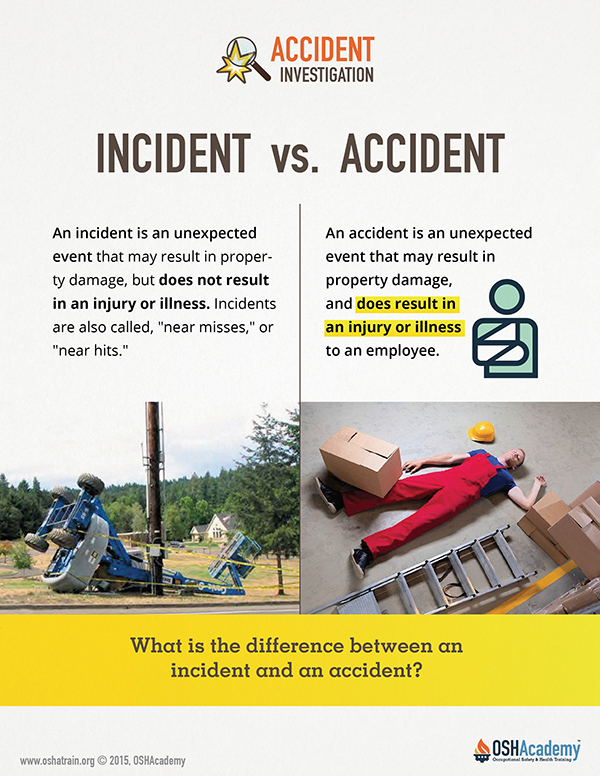Evidence exists that indicates that preventing incidents and maintaining quality is best achieved by implementing a management system designed to control losses. An effective management system is based on a framework of specific principles, performance standards and activities, that have proven to be successful in achieving the desired results. The prevention and control of undesired incidents in the heart of safety, health and environmental systems, and understanding the causes and consequences of incidents is the key control for any organization.
A workplace incident can be defined as an unexpected event that did not cause injury or damage this time but had the potential. "Near miss" or "dangerous occurrence” are also terms for an event that could have caused harm but did not.

The term "accident" can be defined as an unplanned event that interrupts the completion of an activity, and that may (or may not) include injury or property damage.
An incident usually refers to an unexpected event that did not cause injury or damage this time but had the potential. "Near miss" or "dangerous occurrence" are also terms for an event that could have caused harm but did not.
Please note: The term incident is used in some situations and jurisdictions to cover both an "accident" and "incident". It is argued that the word "accident" implies that the event was related to fate or chance. When the root cause is determined, it is usually found that many events were predictable and could have been prevented if the right actions were taken - making the event not one of fate or chance (thus, the word incident is used). For simplicity, we will use the term accident to mean all the above events.

The information that follows is intended to be a general guide for supervisors or joint occupational health and safety committee members. When accidents are investigated, the emphasis should be concentrated on finding the root cause of the accident rather than the investigation procedure itself so you can prevent it from happening again. The purpose is to find facts that can lead to actions, not to find fault. Always look for deeper causes. Do not simply record the steps of the event.
An incident investigation is the account and analysis of an incident based on information gathered by a thorough examination of all contributing factors and causes involved.
Investigation procedures need to be systematic.
Incident Investigation

An incident investigation is the account and analysis of an incident based on information gathered by a thorough examination of all contributing factors and causes involved.
For any investigation the team should:
- Act as soon as possible after the incident
- Visit the scene before physical evidence is disturbed
- Not prejudge the situation
- Not remove anything from the scene
- Enquire if anyone else has moved anything and
- Take photographs and/or sketches to assist in reconstructing the incident.
Sample Regulations, codes, and standards focused on management systems for incident prevention:
- Occupational Safety and Health Administration – 29CFR1910.119 Process Safety Management of Highly Hazardous Chemicals.
- International Organization for Standardization – 14001:2004 Environmental Management System.
- International Organization for Standardization - ISO 9001:2015 - Quality management systems.
- International Organization for Standardization - OHSAS 18001:2007 – Occupational Health and Safety Assessment Series.
Click on the link/s below to open the resources.